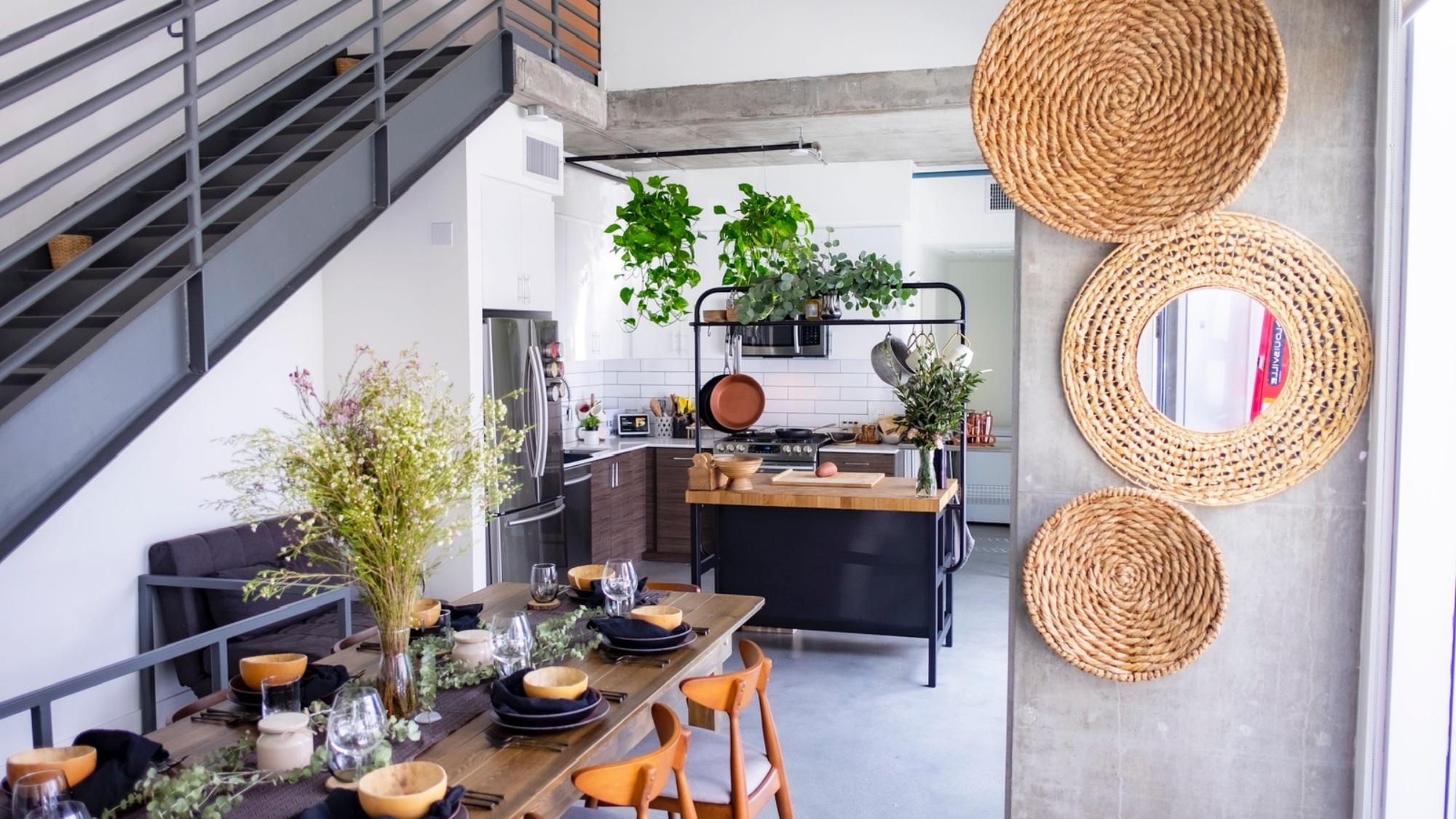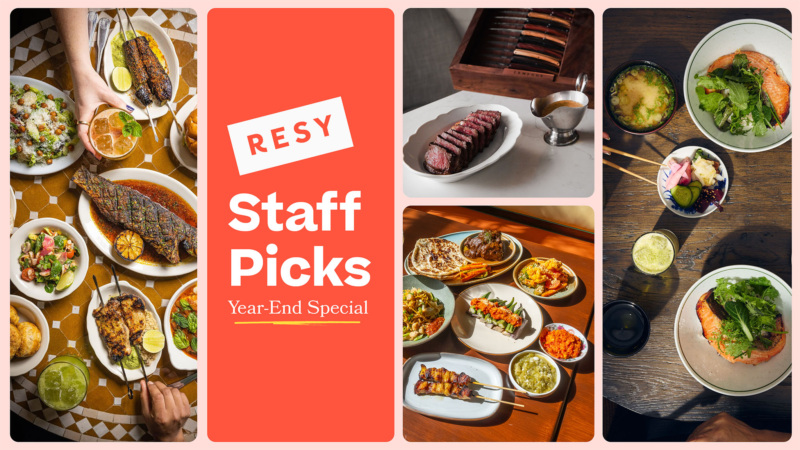
At Ilé, Tolu ‘Eros’ Erogbogbo Tells a Story of West African Food
For the past year, Nigerian chef Tolu “Eros” Erogbogbo has been inviting guests into his Hollywood live-work loft for Ilé, an immersive West African meal that’s best described as an experience. Once you’re warmly ensconced in the modern loft, Erogbogbo and his team whip up an upscale, multi-course meal featuring dishes that run the gamut from smoky pepper soup to seafood toast and jollof rice adorned with gold leaf. Accompanying the dishes at the communal-style dining tables is a story, performed by Erogbogbo to a soundtrack of East and West African tunes and lively conversations.
Erogbogbo constructs each meal — or really, each dinner party — like an album, highlighting his greatest hits and sprinkling in some new tracks every now and then. Over time, it’s been finely produced into the refined experience you walk into today. And it’s taken on new forms, too: In March, Erogbogbo and his partner David Olusoga opened a fast-casual restaurant at Culver City’s Citizen Public Market, Ilé Bistro, which focuses on customizable jollof rice bowls.
Ilé isn’t Erogbogbo’s first foray into the food world. The self-taught chef, who hails from Benin City, Nigeria, left home to study international business in the United Kingdom, only to return at 21 to open a restaurant with his mother. Since then, he’s been what he calls a “serial entrepreneur,” launching a catering business, bakery, and another restaurant. He even gained his moniker “The Billionaire Chef” after cooking for some of Nigeria’s wealthiest folks.
But the course of Erogbogbo’s life changed after embarking upon a three-month trip to the States, where he hosted pop-up dinners across the country. Those events were so successful that the chef decided to stay in L.A. and launch Ilé as a permanent fixture in March of 2022. Ilé, which translates to “home” in his Yorùbá language, is Erogbogbo’s way of bringing the nostalgic memories of home into his new city. We spoke with the chef about his mission to reimagine West African food, his motivation behind the storytelling-based dinner format, and what’s on the horizon for Ilé.
- Wes Avila Wants You to See His Mexican Cooking At Ka’teen As Pure L.A.
- The Ruby Fruit is Revitalizing America’s Lesbian Bar Scene
- Nearly A Decade In, Gasolina Is Still Revving Its Engine
- Pizzana’s Daniele Uditi Wants to Spread the Gospel of ‘Slow Dough’ Across America
- How Camphor is Changing What Fine Dining Means In L.A.


What’s behind your motivation to launch Ilé here in L.A.?
Tolu “Eros” Erogbogbo: Our goal has really always been to put West African cuisine on the global food map and to debunk the idea that West African food is too spicy, too oily, and not beautiful enough. We focused on modernizing the [cooking] processes, while staying authentic to the taste. Nigerian food has a great taste, but over the years, it hasn’t really evolved as much. We spent some time trying to work on the evolution of the cuisine itself, which is why we [consider Ilé] a contemporary Nigerian restaurant.
What role does storytelling play in Ilé’s dining experience?
Storytelling has been a huge part of the success story of Ilé. We’ve been able to focus on a bunch of different stories across different menus. When we started our first menu last year, it was called “Back to Basics,” which explored basic Nigerian and Ghanian street food. Now, we’re on a menu called “The Journey,” which dives into the experiences of seven different people from seven different cultures within West Africa, who have all traveled for greener pastures.
I create all the stories and the menus. I pull inspiration from everything around me: going to the farmers markets, hiking, traveling, visiting people, and listening to music. Some of the stories are real, like the ones about my [relatives], and some are fictional, including stories taught to us growing up. They are really just about channeling emotions.
You have music, storytelling, and food all going on in your live-work loft. Why did you choose this format for Ilé?
I’d always heard about chef’s tables, but I wanted to create something that was a representation of a true chef’s table, where you can literally come into a chef’s home and eat at the table that he dines at himself. I grew up around the dining table and I really wanted to relive the emotions and bring back that memory of sitting around it. Some of the biggest deals in the world happen around a dining table, so I wanted to bring people from different walks of life and cultures together.
Some of the biggest deals in the world happen around a dining table, so I wanted to bring people from different walks of life and cultures together.— Tolu “Eros” Erogbogbo
And I really wanted to be able to tell the stories of my people and channel that through music, tastes, and the general ambience of the space. Some of the songs I play are “Beautiful Rain” by The Cavemen, “African Queen” by 2Face, and “Good Thing” by Aṣa. The space is very warm. It just feels like you’re home and the stories ignite the whole experience.


In regards to the food, I understand you source many of your ingredients from Nigeria. What do you bring back and why?
Since I was a child, my mother has always purchased pepper spices from one particular lady. I grew up with those spices and I didn’t want to change that. I also like to be able to continue to support local trade as I’m very passionate about giving back to my community. And so even though I’m far away from home, my influence is still felt there. Every month, my business goes back to the same suppliers — and now on a much larger scale — getting spices like uyayak, calabash nutmeg, Grains of Selim, gbafilo, alligator pepper, uziza, and suya.
What are a few of the dishes you’re serving right now that stand out to you? And what makes them special in terms of ingredients and technique?
Pepper soup is usually the dish that everyone says is memorable and it’s because of how this one big dish makes you feel. It feels medicinal without tasting medicinal, like you’re drinking a warming broth. The difference here is really the construction of the dish itself: the smoking of the turkey that’s used in the soup, and the sweetening of the habanero into a jam. Typically, you’d see carrots in the broth, but in this one, I use a carrot purée that has hints of avocado and a bit of the spice mix itself, and then I top it with edible flowers to make a beautiful presentation.
I also love jollof risotto. Mine is a fusion of the Italian rice dish with a West African rice dish. Really, this is telling my mother’s story. My mother’s favorite city is Florence and she would travel there, looking for risotto, and then come back home and ask for jollof rice. In telling that story, we merged the jollof rice base with the risotto along with wine, flambéed carrots, and caramelized onion sauce.


How about dessert?
Puff puff is something we’ve put on our menu a few times, but we’ve found a way to redefine it each time. Right now, we’re doing a puff puff funnel cake. It’s as if a doughnut and a beignet made love and had a baby that looked like funnel cake. We made this custard a while ago where instead of using vanilla, we used a spice called uyayak prekese. It’s a long spice that’s typically used in making pepper soup, but it has a sweet caramel-like flavor. It became the most delicious custard I’d ever had. And then we took that custard and converted it into an ice cream. We told the story of a melting cream because whenever I tried to serve ice cream in Nigeria, it immediately starts to melt because it’s so hot outside. So we created the ice cream that way intentionally — when we put it on the plate it sort of melts a little bit, with the foam of the ice cream sitting on the bed of cream itself.
What are your future plans for Ilé?
With the private dining room, we eventually want to see it in Las Vegas, like Cirque du Soleil, where we have an African burlesque dining experience. For Ilé Bistro, the goal would be to open multiple locations around the world and truly be able to give people access to quality Nigerian and West African dishes that they can rely on with good quality and great taste.
Jean Trinh’s food and culture stories have appeared in Los Angeles Times, Food & Wine, and The New York Times. Follow her on Twitter and Instagram. Follow Resy, too.
Discover More

Stephen Satterfield's Corner Table















